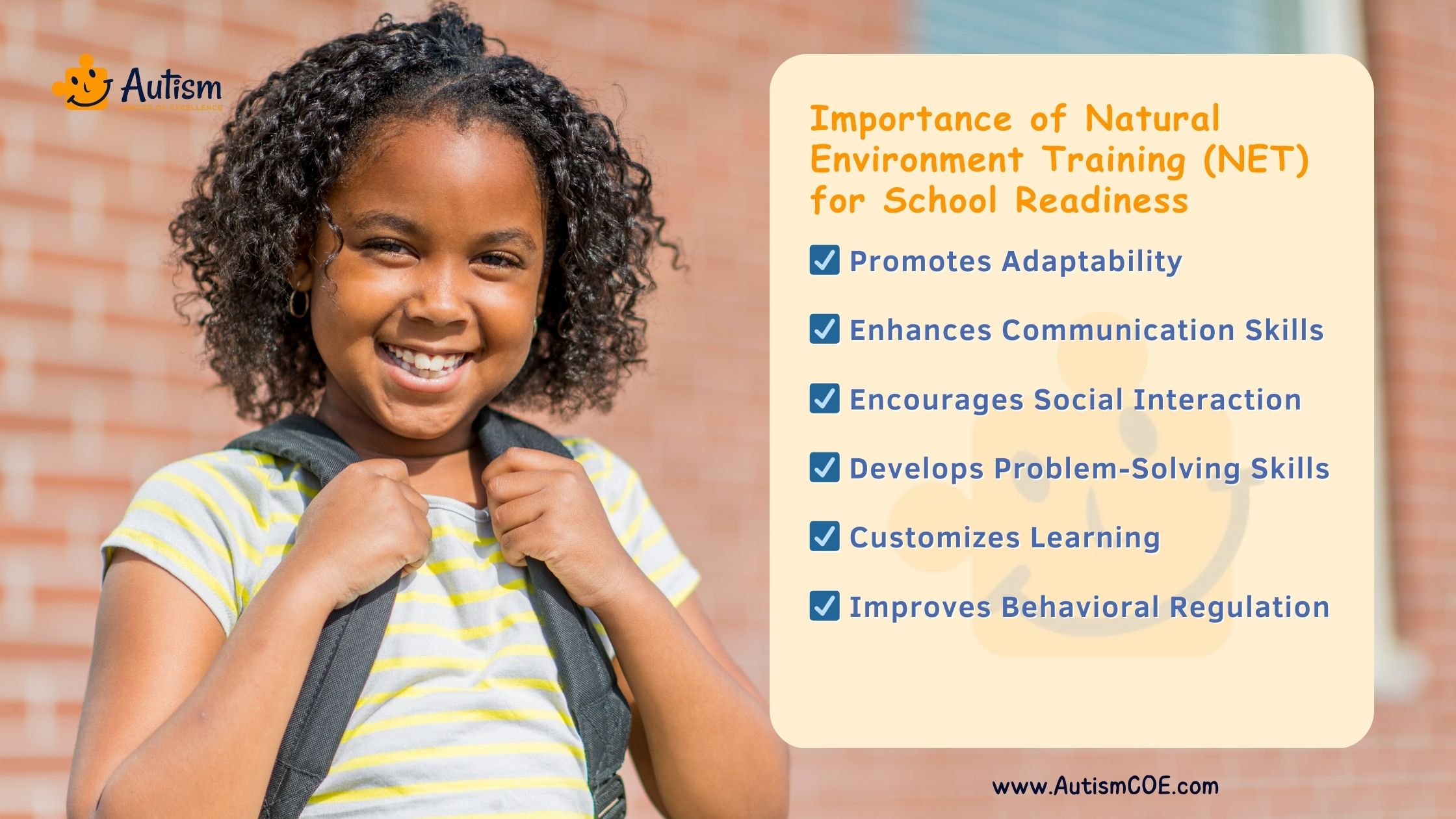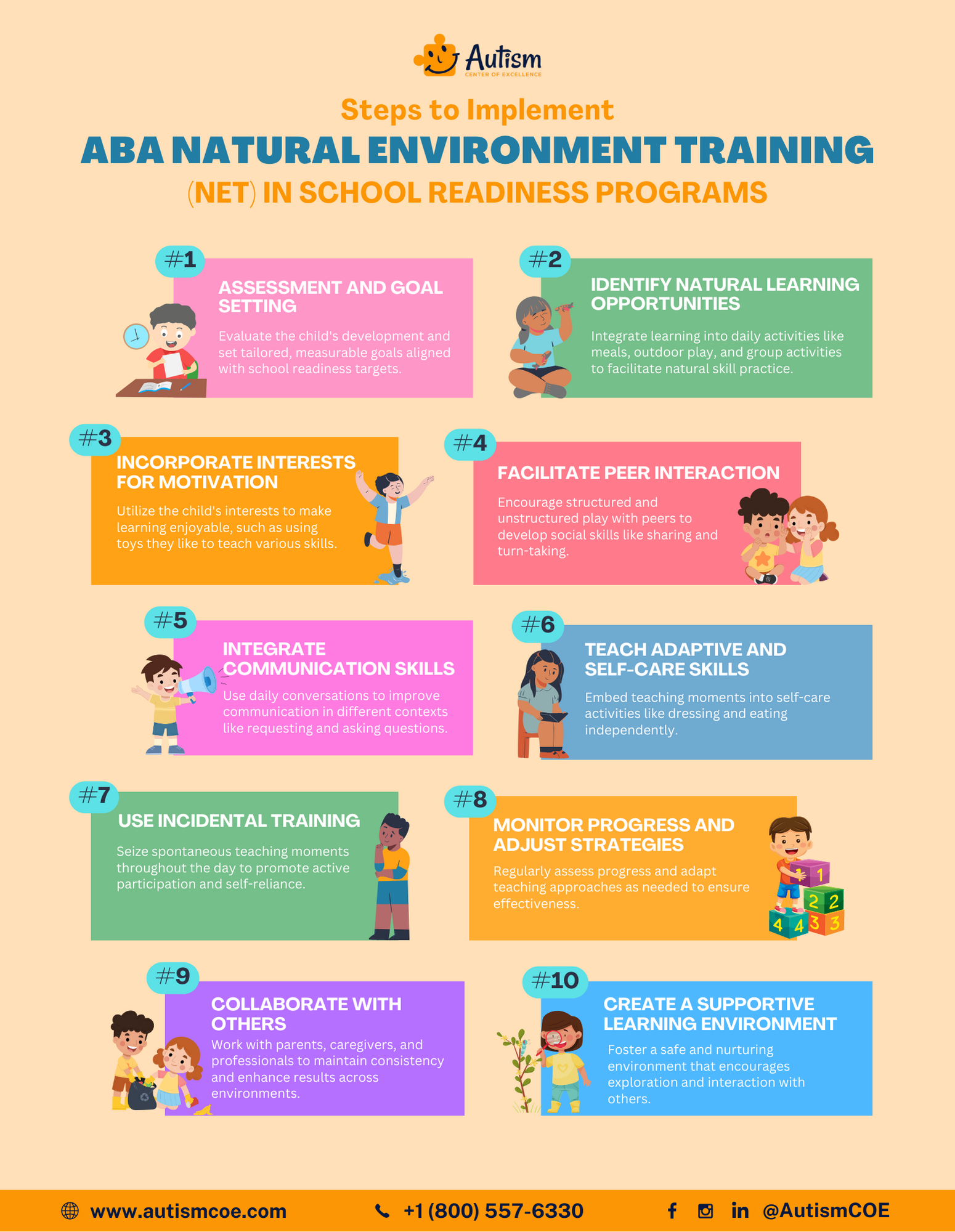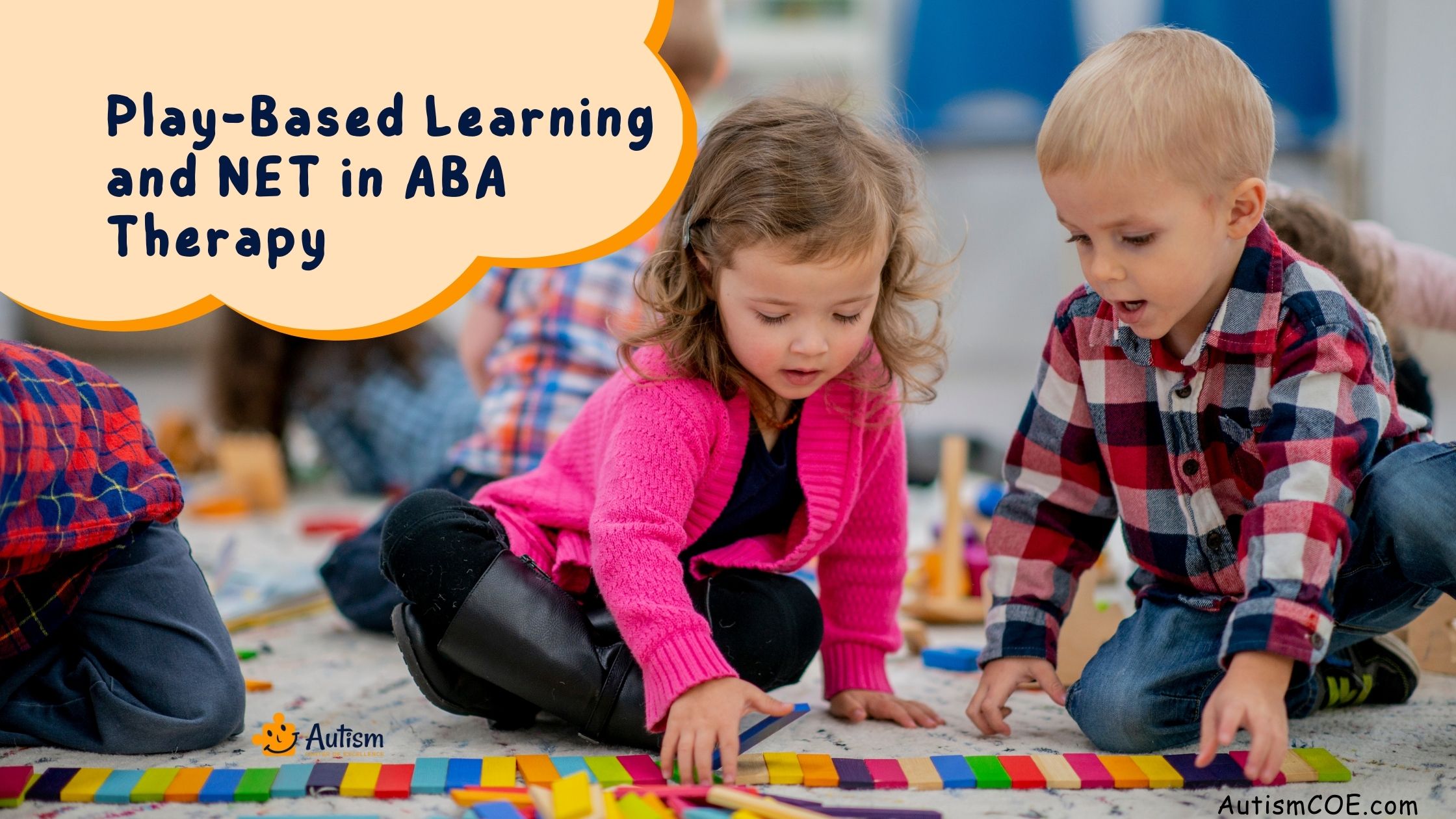Unit 27: Natural Environment Training (NET) in ABA for Effective School Readiness

Educating children, particularly those with autism, is like nurturing a garden. Every plant requires a unique approach to flourish. This individualized approach is also adopted by the Natural Environment Training (NET) in Applied Behavior Analysis (ABA) so that learning is made as natural as possible and at the same time it is an enjoyable process. Its effect on School Readiness for Children with Autism is far-reaching, particularly as we strive to transition them in a more seamless manner into more traditional educational environments. This article is targeted at parents and special education teachers who aim at understanding and using NET as part of their educational strategies.
What is Natural Environment Training in ABA?
In essence, Natural Environment Training or Natural Environment Teaching represents a technique used within Applied Behavior Analysis in order to facilitate language, playing, and social skills within a learner’s natural environment which is contrasted with the contrived setting. This approach capitalizes on the daily activities and encounters that a child has to make learning more spontaneous and fun.
The scope of NET was not of one person’s genius but was the result of practices and principles established by several pioneers of behavior analysis. It is based on the early work of Lovaas but has been developed by many other practitioners in the field.

The Importance of NET for School Readiness
Moving from informal learning to formal learning can be difficult, particularly for children with autism. NET develops children for school by teaching vital abilities in real environments. This experiential learning model ensures they are prepared both academically and socially to start school.
Promotes Adaptability
The NET uses realistic situations to teach children how to adapt to new environments and situations. This adaptability is important for Autism School Readiness Program because children will be put through different areas and social contexts.
Enhances Communication Skills
NET also enhances language and communication abilities by infusion learning into the day-to-day activities of an individual, which will somehow make it easy for the children to express their needs, ideas, thoughts, and feelings in a school context.
Encourages Social Interaction
These children also tend to engage in Positive Social Interactions with Peers and adults in their environment, which is a critical ability for classroom participation and friendship formation.
Develops Problem-Solving Skills
The practice of daily problems contributes to the development of critical thinking and problem-solving, the core characteristic of school readiness.
Customizes Learning
NET is responsive to the individual needs and interests of the child, and as such, learning is more meaningful and exciting, thus, confidence and enthusiasm for school is enhanced.
Improves Behavioral Regulation
Natural Environment Training helps children to adapt to various settings, a significant aspect of classroom management and academic concentration.
How Does NET Support Children with Autism?
Among those with autism, there are problems with the generalization of learning which is a crucial aspect of an independent life. In this context, Natural Environment Training ABA aims to address the challenge by providing teaching in natural settings such as homes and playgrounds where the skills have a higher likelihood of being utilized in different environments.
For example, instead of only being trained to ask for ‘more’ in a therapy session, a child is trained to use the skill in real-life situations like asking for ‘more’ water at dinner, wanting ‘more’ playtime at the park, or needing ‘more’ crayons while drawing.
NET incorporates learning into everyday routine, ensuring skills are not only applicable but useful in the real world, which significantly improves the ability to manage various social and functional settings independently.

Implementing NET in School Readiness Programs
NET integration in early childhood programs means developing learning experiences that reflect the interests of each child and his/ her daily activities. It is, therefore, an interactive approach, providing structured play, peer interaction, and routines such as a snack or story time where functional skills are practiced in stimulating meaningful contexts.
Steps to Implement Natural Environment Training in School Readiness Programs
#1 Assessment and Goal Setting
Start by evaluating the developmental level, strengths, and weak points of the child. Employ such information in defining targeted and measurable goals which are tailored to the child’s requirements and in line with school readiness targets.
#2 Identify Natural Learning Opportunities
Seek or create teachable moments within the child’s daily schedule. Activities could be meals, outdoor play, or group activities with other children, where the child will get to learn and practice new skills in a natural way.
#3 Incorporate Interests to Motivate Learning
Use the child’s interests to provide more enjoyable learning. For example, if the child likes playing with cars, use toy cars during play to teach counting, colors, or social interaction skills.
#4 Facilitate Peer Interactions
Facilitate that the child engages in play and peer interaction in both structured and unstructured settings. This promotes Acquisition of Social Skills like sharing, turn-taking and expression of wants or needs.
#5 Integrate Communication Skills Development
Turn daily conversations into chances to Improve Your Communication Abilities. Promote the utilization of language in different contexts where it could be used for requesting, commenting, and asking questions, among others.
#6 Teach Adaptive and Self-Care Skills
Embed teaching moments into the daily activities of self-care and adaptive skills practice. Skills like dressing, eating by oneself, and tidying up after play are critical for school readiness.
#7 Use Incidental Training
Look out for opportunities for spur-of-the-moment, teachable moments during the day to support learning. This approach allows the child to start learning situations themselves, which leads to active participation and self-reliance.
#8 Monitor Progress and Adjust Strategies
Periodically assess the child’s progress to the accomplishment of the goals and change the teaching approaches and learning opportunities as required. This confirms that the NET approach continues to be efficient and adaptable to the child’s growing faculties.
#9 Collaborate with Caregivers and Professionals
Collaborate with parents, caregivers, and other professionals who are a part of childcare. Advice and strategies sharing ensures, that results are consistent from one environment to another, therefore, enhancing the effectiveness of NET.
#10 Create a Supportive Learning Environment
Provide a learning environment that is safe, nurturing, and allows for exploration. A good atmosphere forges a sense of security in children and stimulates them to interact with the environment and other people.
Through the integration of these steps in Autism School Readiness Programs, educators and caregivers can utilize NET’s principles to ensure personalized, quality instruction that will enable children, particularly those with autism, to make a smooth change into a formal school setting.
Join Our Weekly Newsletters!
Subscribe now to stay updated with our latest email updates.

Play-Based Learning and NET in ABA Therapy
Play-Based Learning is an essential component of Natural Environment Training in ABA emphasizing the importance of play in a child’s development. Playing allows children to acquire communication, problem-solving, and socialization skills among others.
In ABA, play activities are selected and modified to achieve specific learning targets, capturing the child’s attention to suit their individual needs via their natural motivations. The objective is to provide an exciting and educative environment where learning occurs instinctively while playing. This method not only enhances the process of learning but also encourages a friendly attitude towards learning new skills and knowledge.
Classroom Strategies and NET Techniques
For a NET to be successfully implemented in a classroom or therapeutic setting, flexibility and creativity are necessary. Techniques might include:
- Task Variation: Mixing high and low preference activities to maintain high engagement.
- Incidental Training: Using naturally available settings opportunities to practice or strengthen a skill.
- Manding: Promoting the child to ask for their needs during the day, hence enhancing communicative skills.
- Modeling and Mimicking: Peer Modeling to teach proper social interactions and play behaviors.
All of these approaches serve to strengthen the learning within the environment where it naturally takes place, which makes such learning more meaningful and retainable for the child.
What are the Challenges of NET in ABA?
NET in ABA has many benefits, but also challenges to consider:
- Resource Intensive: NET demands a lot of investment and ingenuity from educators to seek and exploit teachable moments.
- Generalization Challenges: Knowledge acquired in one setting may not have a smooth transition to another without additional training.
- Measurement Difficulties: The informality of NET makes it difficult to evaluate progress and outcomes as one would with a systematic approach.
- Requires Skilled Practitioners: NET requires competency and flexibility from teachers and therapists, which is very difficult to achieve in a resource-restricted environment.
In ABA, having insight into these aspects of NET helps educators, therapists, and caregivers to decide which of these strategies to include in their education and intervention plans.
Frequently Asked Questions & Answer
What is the Meaning of Natural Environment?
The phrase “Natural Environment” refers to the everyday contexts in which children usually spend their time, that is in their home, playground, daycare, community setting, and alike. In contrast to formal, clinical environments, natural settings offer a real-life situation/ context for learning and development, which is characterized by life-like interactions and experiences.
What is the Purpose of Natural Environment Training?
Natural Environment Training aims to teach children, especially those with autism or other developmental issues, important skills in the context of their daily activities. The objective of NET is to make learning more meaningful and interesting incorporating activities or interests that are already motivating to the child. It means that the children easily acquire language, social, and behavioral skills which help the children to transition smoothly to formal education settings and independence in general.
When to Integrate Natural Environment Training?
Natural Environment Training (NET) can be added for children at any stage of their development, but the best effects are achieved during early childhood. The importance of this stage lies in gaining fundamental skills which include communication, socializing, and self-care. Early NET is the most effective, as it follows the natural learning of the child so that they easily generalize the skills in different settings.
How Long Is the Training Duration for Natural Environment Training?
NET is individualized, therefore each person’s needs are taken into consideration and thus time can be prolonged to acquire skills in natural settings. The process could last from weeks to years depending on each individual’s specific problems, the training program being tailored to their rhythm and evolution.
Conclusion
Natural Environment Training (NET) moves towards comprehensive learning in ABA Therapy, targeting learning in natural settings, to promote Readiness for School and generate an enduring love of learning. Parents and educators have an opportunity to watch children’s ability to develop in their natural settings with the help of NET.
AutismCOE suggests beginning with the interests of the child, as a way to incorporate NET in ABA into educational programs. Lessons designed around the things that fascinate them can lead to effective and enjoyable learning. The learning process of every child is individual as such, it takes a lot of time and some special techniques to create conditions under which each and every child will be successful.
Adopting such terms as NET, Natural Environment Training, and Play-Based Learning within ABA in your approach not only aligns with educational best practices but also utilizes successful strategies to prepare for future academic challenges.
Please Note: The content of this blog is for informational purposes only and should not be considered a substitute for professional medical advice, diagnosis, or treatment. Consult a qualified healthcare professional for personalized guidance tailored to your specific situation.

Bhavika Bhasin
Bhavika Bhasin is the Research and Marketing officer at AutismCOE. She works with children and adults with ASD. Her clinical research includes evaluating various available autism screening and diagnosis methods and their efficacy. She is currently developing a novel screening exam that is indicated to be more accurate than the existing available exams. She is also writes articles papers for various publications.

